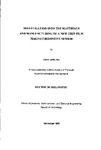INVESTIGATION INTO THE MATERIALS AND MANUFACTURING OF A NEW THIN FILM MAGNETORESISTIVE SENSOR
| dc.contributor.author | MA, YONG QING | |
| dc.contributor.other | School of Engineering, Computing and Mathematics | en_US |
| dc.date.accessioned | 2013-11-22T16:06:02Z | |
| dc.date.available | 2013-11-22T16:06:02Z | |
| dc.date.issued | 1998 | |
| dc.identifier | NOT AVAILABLE | en_US |
| dc.identifier.uri | http://hdl.handle.net/10026.1/2834 | |
| dc.description.abstract |
There is increasing interest in utilising very thin anisotropic magnetoresistive films (typically in the range of a few nano-metres) to make magnetic sensors which can be made very small and with a high signal-to-noise ratio. In this thesis, a new type of sensor is investigated which has a pair of thin film MR stripes whose magnetisation is switched alternately in opposite directions using bias fields from currents in overlay conductor films. The investigation considers in particular the Barkhausen noise in these sensors and its relationship with factors such as sensor film thickness. The effect of thickness and grain size on the coercivity of Ni81Fe19 permalloy thin films deposited by r.f. sputtering with negative substrata bias is systematically investigated as a function of under-layer materials, thickness, and substrata temperature. The results show that there is a minimum in coercivity at a thickness of about 7.5 nm with a grain size of 4 nm. This may be attributed to the grain size via its relationship with magnetic domain wall thickness. A tantalum under-layer favours a (111) (low anisotropy) surface plane in permalloy sensor films. Elevated deposition temperature may reduce defects in the films. A comparison of the magnetic domain wall structure and the state of magnetisation in the very thin (5 - 30 nm) permalloy films with and without Ta underlayer is made by using Lorentz TEM observation. The result shows that it is different in both cases. With Ta underlayer, the wider, straighter and more regular domain walls together with less rippling in magnetisation in adjacent domains may lead to a reduction in the Barkhausen noise. Barkhausen noise studies of films are carried out by sweeping an ac field of 77 Hz onto the permalloy films and recording the induced output voltage due to the flux change as a function of time on a digital storage oscilloscope. Barkhausen noise and corresponding hysteresis of the sensor is studied by analysis of the MR response of various sensors together with their magnetoresistive hysteresis, which may be reduced or improved by using a suitable external high frequency field (5 kHz to 20 kHz). Variation in the sensitivity of the sensor to the magnitude of a switched-biasing field was measured by applying a very small alternating field (from about tens to a few hundreds of nano-Tesla) at frequency above about 250 Hz and varying a transverse de field component (δH.), The effect of biasing field frequency and external linearising field on the sensitivities of these MR sensors is studied using an in-house built measurement system. Highly sensitive magnetoresistive sensors (120 different types have been available within 30 substrates) have been designed and then fabricated by photolithography in a temperature and humidity controlled clean room. Sensor thicknesses are typically in the range from 5 nm to 40 nm and other dimensions typically (10 µm - 80 µm wide) and 6.4 mm long. The sensor is linear in the range from zero to 14 400 nT. It produces an almost noise-free output of 20 to 30 millivolts for a field change of about 160 nano-Tesla. | en_US |
| dc.language.iso | en | en_US |
| dc.publisher | University of Plymouth | en_US |
| dc.title | INVESTIGATION INTO THE MATERIALS AND MANUFACTURING OF A NEW THIN FILM MAGNETORESISTIVE SENSOR | en_US |
| dc.type | Thesis | |
| plymouth.version | Full version | en_US |
| dc.identifier.doi | http://dx.doi.org/10.24382/3896 | |
| dc.identifier.doi | http://dx.doi.org/10.24382/3896 |
Files in this item
This item appears in the following Collection(s)
-
01 Research Theses Main Collection
Research Theses Main


